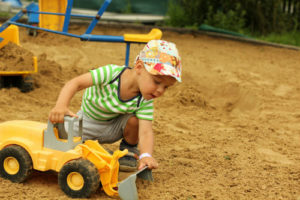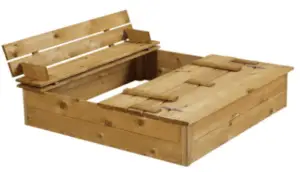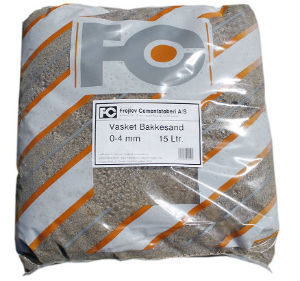 Vidste du at dit barns sandkager kan være fyldt med parasitter? Gamle sandkasser kan afgive sundhedsskadelige dampe, der kan være kræftfremkaldende, og sandet kan indeholde kemikalier. En sandkasse giver mulighed for mange timers god og kreativ leg, og det er er en af de investeringer, man får glæde af i mange år frem. Derfor skal forholdene i sandkassen være gode og sandet skal være rent. Få råd til hvordan du sørger for at dit barns sandkasse er sund og sikker, så den skaber de bedste rammer for mange timers sjov leg.
Vidste du at dit barns sandkager kan være fyldt med parasitter? Gamle sandkasser kan afgive sundhedsskadelige dampe, der kan være kræftfremkaldende, og sandet kan indeholde kemikalier. En sandkasse giver mulighed for mange timers god og kreativ leg, og det er er en af de investeringer, man får glæde af i mange år frem. Derfor skal forholdene i sandkassen være gode og sandet skal være rent. Få råd til hvordan du sørger for at dit barns sandkasse er sund og sikker, så den skaber de bedste rammer for mange timers sjov leg.
Her kan du se gode og nemme råd til hvordan du selv kan sørge for at dit barns sandkasse er sund og sikker.
Indholdsfortegnelse
Derfor bør sandkassen være dækket til med sandkassenet eller et låg
Når sandkassen er dækket til holder sandet sig rent og fint længere tid, da blade og snavs ikke så nemt bliver blandet med sandet. Det forhindrer også katte, mus og ræve i at færdes i sandkassen. Med andre ord, bør du sække din sandkasse til med låg, så snart den ikke er i brug. En sandkasse med låg kan dækkes til om natten, eller hvis den ikke bruges i længere perioder. I vinterhalvåret bruges sandkassen måske ikke hver dag, og i sommerferien er der ofte et par uger man ikke er hjemme.
Husk der skal kunne komme luft til sandet:
Det vigtige er, at der skal kunne komme luft til sandet så det kan tørre. Ellers skabes der fugt og kondens under låget, hvilket giver grobund for svamp og mug.
Låg eller overdækken til sandkassen kan være
- Trælåg
- Dækken
- Net til sandkasse

Sandkasse med låg i træ
Et trælåg fungerer godt, da der stadig kan komme luft til sandet. Det er smart hvis låget kan klappes op, og bruges som sæder. Så har børnene et godt og tørt sted at sidde når de skal lege, og samtidig slipper man for at flytte rundt på et tungt, uhåndterligt låg. Sandkassen er i lærketræ, som er den træsort der anbefales til sandkasser.
Dækken til sandkasse
Til mange sandkasser medfølger et dækken, der passer til sandkassen størrelse og udformning. Hvis det blæser meget kan man ligge 1-2 mellemstore sten oven på sit dækken til sandkassen for at forhindre det i at blæse væk.
Vær opmærksom på, at et dækken lader ikke luft komme ned til sandet, så husk at tage det af ind imellem, hvis der er en længere periode, hvor sandkassen ikke er i brug. Til gengæld er et dækken effektivt til at holde blade og snavs væk fra sandkassen.
Net til sandkasse
Det kan være en god ide at bruge et net til sandkasse, for at dække den til. Det forhindrer dyr i at komme igennem til sandet, og lader samtidig masser af luft igennem. Til nogen sandkasser medfølger et dækken, som også fungerer godt til at overdække sandkassen. Et dækken holder tæt, og forhindrer blade og andet snavs i at ligge sig oven på sandkassen, og blande sig med sandet. Bunden af sandkassen skal tillade vand at løbe væk fra sandet, men samtidig forhindre ukrudt i at vokse op i sandkassen. En sandkasse med internt bunddække er derfor at fortrække. Du kan købe et billige sandkassenet hos 10-4 byggemarked.
Sådan holder du sandet rent
- Sandet bør udskiftes min. én gang årligt

Sundhedsmyndighederne anbefaler, at sand til sandkasse udskiftes minimum én gang årlig af hygiejniske årsager. Når børn leger i sandkassen, sidder de måske og spiser frugt eller kiks, der så blandes sammen med sandet. Hvis sandkassen ikke har været overdækket er der risiko for mus, ræve eller katte har færdes i sandet i sandkassen, og efterladt ekskrementer og bakterier. Det kan derfor blive en giftig mundfuld, hvis dit barn smager på sand i sandkassen. Det gamle sand kan du skille dig af med ved at putte det i poser, der ikke er for tunge til at bære, og derefter køre dem på genbrugspladsen.
Derfor er placering af sandkassen vigtig
Sørg for at sandkassen ikke er placeret lige under et træ, hvor der kan falde blade og andet snavs direkte ned i sandkassen. Placer den i et åbent område, hvor du også samtidig kan holde opsyn med dit barn. Hav en parasol ved sandkassen, så barnet ikke sidder i direkte sol. Det kan ikke undgås, at der ryger sand ved siden af sandkassen, så sandkassen skal måske ikke være placeret lige op af dit yndlingsbed, der i så fald vil blive fyldt med sand.
Køb det rigtige sandkassesand
Sand til sandkassen er fint og indeholder ikke sten. Det tørrer hurtigt og egner sig godt til at lave sandslotte og sandkkager med.
Det kan være fristende at afhente gratis sand fra grusgrave eller industrien, men det frarådes af sundhedsmyndighederne, da sandet kan være snavset og indeholde rester af kemikalier.
Køb derfor sand til sandkassen i byggemarkeder. Du kan med fordel bestille det på nettet – fx her – , så du slipper for selv at slæbe det hjem. Når du skal købe sand til sandkasser skal du kigge efter betegnelserne
- strandsand
- vasket sand
Sandet købes ofte i 15 liters sække. Skal du have meget sand, kan du købe en trailerfuld til afhentning.
Køb det rigtige sandkassesand
Sand til sandkassen er fint og indeholder ikke sten. Det tørrer hurtigt og egner sig godt til at lave sandslotte og sandkkager med.
Det kan være fristende at afhente gratis sand fra grusgrave eller industrien, men det frarådes af sundhedsmyndighederne, da sandet kan være snavset og indeholde rester af kemikalier.
Køb derfor sand til sandkassen i byggemarkeder. Du kan med fordel bestille det på nettet – fx her – , så du slipper for selv at slæbe det hjem. Når du skal købe sand til sandkasser skal du kigge efter betegnelserne
- strandsand
- vasket sand
Sandet købes ofte i 15 liters sække. Skal du have meget sand, kan du købe en trailerfuld til afhentning.
Hvilket materiale skal sandkassen være lavet af?
Sandkassen skal være i et materiale, der ikke afgiver giftige dampe eller skarpe kanter. Blødt træ uden farlige splinter eller grove kanter egner sig bedst. Det er også en fordel hvis barnet kan sidde på kanten af sandkassen, hvor der er tørt og behageligt.
Det skal du vide om trykimprægneret træ
Mange sandkasser er lavet i trykimprægneret træ. Træet har gennemgået en kemisk proces, der gør det holdbart og egnet til at stå udendørs i mange år. Sørg for det trykimprægneret træ er godkendt og lever op til sikkerhedsstandarter. Alle sandkasser i trykimprægneret træ hos Sundleg er uden skadelig kemi.
Det skal du undgå…
Undgå Sandkasser lavet i jernbanesveller eller telefonpæle, da man har fundet ud af de afgiver giftige kemikalier. Sandkasser lavet i blødt træ med afrundede hjørner er at fortrække. Heldigvis er disse efterhånden udryddet fra legepladser.
—
Kilder : sundhedsplejersken.dk

